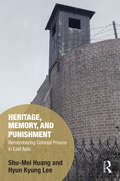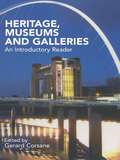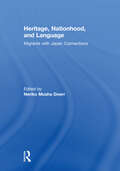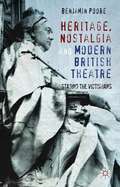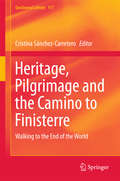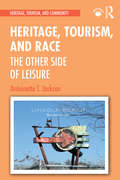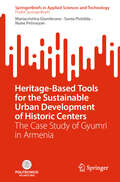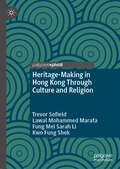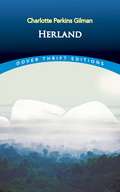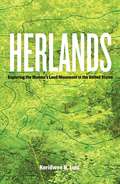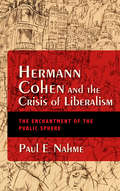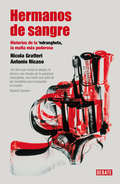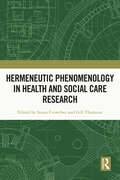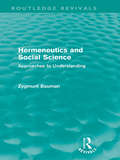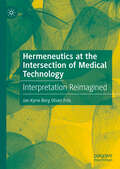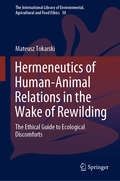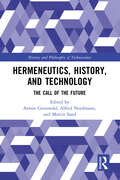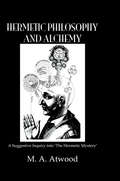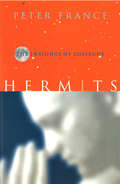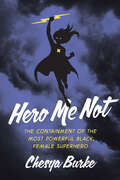- Table View
- List View
Heritage, Memory, and Punishment: Remembering Colonial Prisons in East Asia (Memory Studies: Global Constellations)
by Shu-Mei Huang Hyun-Kyung LeeBased on a transnational study of decommissioned, postcolonial prisons in Taiwan (Taipei and Chiayi), South Korea (Seoul), and China (Lushun), this book offers a critical reading of prisons as a particular colonial product, the current restoration of which as national heritage is closely related to the evolving conceptualization of punishment. Focusing on the colonial prisons built by the Japanese Empire in the first half of the twentieth century, it illuminates how punishment has been considered a subject of modernization, while the contemporary use of prisons as heritage tends to reduce the process of colonial modernity to oppression and atrocity – thus constituting a heritage of shame and death, which postcolonial societies blame upon the former colonizers. A study of how the remembering of punishment and imprisonment reflects the attempts of postcolonial cities to re-articulate an understanding of the present by correcting the past, Heritage, Memory, and Punishment examines how prisons were designed, built, partially demolished, preserved, and redeveloped across political regimes, demonstrating the ways in which the selective use of prisons as heritage, reframed through nationalism, leaves marks on urban contexts that remain long after the prisons themselves are decommissioned. As such, it will appeal to scholars of sociology, geography, the built environment, and heritage with interests in memory studies and dark tourism.
Heritage, Museums and Galleries: An Introductory Reader
by Gerard CorsaneBringing the reader the very best of modern scholarship from the heritage community, this comprehensive reader outlines and explains the many diverse issues that have been identified and brought to the fore in the field of heritage, museums and galleries over the past couple of decades. The volume is divided into four parts: presents overviews and useful starting points for critical reflection focuses more specifically on selected issues of significance, looking particularly at the museum's role and responsibilities in the postmodern and postcolonial world concentrates on issues related to cultural heritage and tourism dedicated to public participation in heritage, museum and gallery processes and activities. The book provides an ideal starting point for those coming to the study of museums and galleries for the first time.
Heritage, Nationhood, and Language: Migrants with Connections to Japan
by Neriko Musha DoerrThe notion of "heritage" has become one of the global tropes in recent years. At the heart of heritage politics are three questions: what heritage is, who decides what it is, and for whom is the decision made. However, existing work on heritage language has rarely tackled these questions, assuming that teaching children of migrants their "heritage language" empowers them.This book challenges this assumption, situating the notion of heritage language in the host society’s involvement in social justice, nation-building efforts, (superficial) celebration of diversity, and investment on global links the migrants offer as well as the migrants’ fear of discrimination and desire for belonging, social status, and economic gain. Based on ethnographic research in Bolivia, Peru, the United States, and Japan, the book illuminates the complexity and political nature of determining what constitutes heritage language for migrants with connections to Japan. This volume opens up a new field of investigation in heritage language studies: the complex linkage between heritage language and social justice for migrants.This book was published as a special issue of Critical Asian Studies.
Heritage, Nostalgia and Modern British Theatre
by Benjamin PooreThe Victorians, having once been seen as 'them', the age responsible for the mistakes of the past, were transformed by the new theatrical forms of the 1960s into 'us', a metaphor for what the nation thinks (and fears) about itself. And, since the 1980s and the rise of new biographical forms in the theatre, the emphasis has shifted further, from 'we' to 'me': plays about individuals, great and small, and their struggles for personal validation. This study argues powerfully that the stage portrayal of the Victorians in recent times is a key reference point in understanding notions of Britishness, heritage and nostalgia, and the profound politicisation of national identity over the last four decades. Using many examples drawn from theatre archives, and throwing new light on works by canonical playwrights like Bond, Edgar, and Churchill, it charts the decline in class-based narratives of the British people and the move towards plays reflecting a more atomised, individuated society, preoccupied with identity and the past but no longer able to provide a convincing account of itself as a nation.
Heritage, Pilgrimage and the Camino to Finisterre
by Cristina Sánchez-CarreteroThis book presents research concerning the effects of the Camino to Finisterre on the daily lives of the populations who live along the route, and the heritagization processes that exploitation of the Camino for tourism purposes involves. Rather than focusing on the route to Santiago de Compostela and the pilgrimage itself, it instead examines a peculiar part of the route, the Camino to Finisterre, employing multiple perspectives that consider the processes of heritagization, the effects of the pilgrimage on local communities, and the motivations of the pilgrims. The book is based on a three-year research project and is the result of a multidisciplinary collaboration between anthropologists, sociologists, historians and archaeologists. Instead of ending in Santiago, as the rest of the Caminos do, this route continues to the cape of Finisterre on the Galician Atlantic coast. This part of the Camino de Santiago is not officially recognized by the Catholic Church and does not count as part of reaching Compostela, the recognition granted by the Catholic Church to those pilgrims who have walked at least 100 km. For this reason, as well as its relationship with the sun cult, many pilgrims call this route "the Camino of the atheists. " In fact, the Catholic Church is a strong force for the heritagization of the rest of the Caminos, and maintains a clear ignoratio strategy concerning the Finisterre route: Officially, the church neither opposes nor recognizes this route.
Heritage, Tourism, and Race: The Other Side of Leisure (Heritage, Tourism, and Community)
by Antoinette T JacksonHeritage, Tourism, and Race views heritage and leisure tourism in the Americas through the lens of race, and is especially concerned with redressing gaps in recognizing and critically accounting for African Americans as an underrepresented community in leisure. Fostering critical public discussions about heritage, travel, tourism, leisure, and race, Jackson addresses the underrepresentation of African American leisure experiences and links Black experiences in this area to discussions of race, place, spatial imaginaries, and issues of segregation and social control explored in the fields of geography, architecture, and the law. Most importantly, the book emphasizes the importance of shifting public dialogue from a singular focus on those groups who are disadvantaged within a system of racial hierarchy, to those actors and institutions exerting power over racialized others through practices of exclusion. Heritage, Tourism, and Race will be invaluable reading for academics and students engaged in the study of museums, as well as architecture, anthropology, public history, and a range of other disciplines. It will also be of interest to museum and heritage professionals and those studying the construction and control of space and how this affects and reveals the narratives of marginalized communities.
Heritage-Based Tools for the Sustainable Urban Development of Historic Centers: The Case Study of Gyumri in Armenia (SpringerBriefs in Applied Sciences and Technology)
by Mariacristina Giambruno Sonia Pistidda Nune PetrosyanThis book proposes a heritage-based approach for the sustainable urban development of the historic cities. The rapid growth of the cities, under the pressure of globalization processes and climate changes, implies deep transformations in their cultural asset, neglecting the role of urban heritage. Often urban planning instruments are not properly equipped with tools capable of managing the complexity of historic cities. The book fills a gap in the implementation of urban transformation, taking into consideration the urgency to protect sensitive and fragile parts of the historic city. The heritage-based tools are experimented with by using a unique case study in the Armenian context: the city of Gyumri and its historic center that, after the 1988 earthquake, suffered from a progressive degradation of its historical heritage. The book serves as a support for the implementation of the planning and regulation for the specific case study and as a methodological approach for planning the historic centers, replicable in other Armenian old cities and similar cities outside Armenia. It provides a framework for protecting the historic environment and buildings, as well as a tool for urban identity protection and a driver for economic development. The practical guidance also offers suggestions to inhabitants and technicians who must deal with the preservation of buildings and open spaces.
Heritage-Making in Hong Kong Through Culture and Religion
by Trevor Sofield Lawal Mohammed Marafa Fung Mei Li Kwo Fung ShekThis book centres on religious heritage-making where religion as a rich and diverse manifestation of culture and community empowerment lead to the transformation of place. Fusing heritage and religion in the novel multidisciplinary concept ‘heri-ligion’, the authors illuminate the dynamics of change inherent in religious-oriented heritage-making. Grounded in empirical evidence, this rich concept integrates religious tourism, heritage tourism, and community-based empowerment for sustainable development. Applying this unique concept to the once abandoned Hakka village of Yim Tin Tsai, the authors analyse the evolving paths of the island from its Hakka origins to a Christian pilgrimage site, and more recently, to a UNESCO cultural heritage site and thriving tourist destination. The authors foreground the important role of the scattered community as a key agent of change in facilitating a sustainable environment of Hong Kong’s only salt-producing place today. A dynamic example of community development and empowerment founded upon religious, cultural, industrial and natural heritage, this book uniquely contributes to tourism and heritage studies, human geography, cultural sociology, Hakka studies, Asian studies, and anthropology of religion.
Heritage: Critical Approaches
by Rodney HarrisonHistoric sites, memorials, national parks, museums…we live in an age in which heritage is ever-present. But what does it mean to live amongst the spectral traces of the past, the heterogeneous piling up of historic materials in the present? How did heritage grow from the concern of a handful of enthusiasts and specialists in one part of the world to something which is considered to be universally cherished? And what concepts and approaches are necessary to understanding this global obsession? Over the decades, since the adoption of the World Heritage Convention, various ‘crises’ of definition have significantly influenced the ways in which heritage is classified, perceived and managed in contemporary global societies. Taking an interdisciplinary approach to the many tangible and intangible ‘things’ now defined as heritage, this book attempts simultaneously to account for this global phenomenon and the industry which has grown up around it, as well as to develop a ‘toolkit of concepts’ with which it might be studied. In doing so, it provides a critical account of the emergence of heritage studies as an interdisciplinary field of academic study. This is presented as part of a broader examination of the function of heritage in late modern societies, with a particular focus on the changes which have resulted from the globalisation of heritage during the late twentieth and early twenty-first centuries. Developing new theoretical approaches and innovative models for more dialogically democratic heritage decision making processes, Heritage: Critical Approaches unravels the relationship between heritage and the experience of late modernity, whilst reorienting heritage so that it might be more productively connected with other pressing social, economic, political and environmental issues of our time.
Herland: Large Print (Dover Thrift Editions)
by Charlotte Perkins GilmanA prominent turn-of-the-century social critic and lecturer, Charlotte Perkins Gilman is perhaps best known for her short story "The Yellow Wallpaper," a chilling study of a woman's descent into insanity, and Women and Economics, a classic of feminist theory that analyzes the destructive effects of women's economic reliance on men.In Herland, a vision of a feminist utopia, Gilman employs humor to engaging effect in a story about three male explorers who stumble upon an all-female society isolated somewhere in South America. Noting the advanced state of the civilization they've encountered, the visitors set out to find some males, assuming that since the country is so civilized, "there must be men." A delightful fantasy, the story enables Gilman to articulate her then-unconventional views of male-female roles and capabilities, motherhood, individuality, privacy, the sense of community, sexuality, and many other topics.Decades ahead of her time in evolving a humanistic, feminist perspective, Gilman has been rediscovered and warmly embraced by contemporary feminists. An articulate voice for both women and men oppressed by the social order of the day, she adeptly made her points with a wittiness often missing from polemical writings. This inexpensive edition of Herland will charm readers with the tale's mischievous, ironic outlook.
Herlands: Exploring the Women's Land Movement in the United States
by Keridwen N. LuisHow women-only communities provide spaces for new forms of culture, sociality, gender, and sexuality Women&’s lands are intentional, collective communities composed entirely of women. Rooted in 1970s feminist politics, they continue to thrive in a range of ways, from urban households to isolated rural communes, providing spaces where ideas about gender, sexuality, and sociality are challenged in both deliberate and accidental ways. Herlands, a compelling ethnography of women&’s land networks in the United States, highlights the ongoing relevance of these communities as vibrant cultural enclaves that also have an impact on broader ideas about gender, women&’s bodies, lesbian identity, and right ways of living.As a participant-observer, Keridwen N. Luis brings unique insights to the lives and stories of the women living in these communities. While documenting the experiences of specific spaces in Massachusetts, Tennessee, New Mexico, and Ohio, Herlands also explores the history of women&’s lands and breaks new ground exploring culture theory, gender theory, and how lesbian identity is conceived and constructed in North America. Luis also discusses how issues of race and class are addressed, the ways in which nudity and public hygiene challenge dominant constructions of the healthy or aging body, and the pervasive influence of hegemonic thinking on debates about transgender women. Luis finds that although changing dominant thinking can be difficult and incremental, women&’s lands provide exciting possibilities for revolutionary transformation in society.
Hermanas: Deepening Our Identity and Growing Our Influence
by Natalia Kohn Rivera Noemi Vega Quiñones Kristy Garza RobinsonGod calls Latinas to lives of influence. He created his Latina daughters to partner with him, live into the incredible plans he has for each of us, and walk in his grace and strength to help change this world. But many of us have heard cultural messages that make us doubt our adequacy. We have not seen many Latina women in positions of leadership, and we need more mentors and role models. Natalia Kohn, Noemi Vega Quiñones, and Kristy Garza Robinson share their own journeys as Latinas and leaders. They find mentorship in twelve inspirational women of the Bible including Esther, Rahab, Mary, and Lydia, who navigated challenges of brokenness and suffering, being bicultural, and crossing borders. As we deepen our spiritual and ethnic identities, we grow in intimacy with God and others and become better equipped to influence others for the kingdom. The insights here will help any who seek to empower Latinas in leadership. You are not alone on this journey. Join your sisters and partner with our heavenly Father as you become the Latina leader God has called you to be.
Hermann Cohen and the Crisis of Liberalism: The Enchantment of the Public Sphere (New Jewish Philosophy and Thought)
by Paul E. NahmeHermann Cohen (1842–1918) is often held to be one of the most important Jewish philosophers of the nineteenth century. Paul E. Nahme, in this new consideration of Cohen, liberalism, and religion, emphasizes the idea of enchantment, or the faith in and commitment to ideas, reason, and critique—the animating spirits that move society forward. Nahme views Cohen through the lenses of the crises of Imperial Germany—the rise of antisemitism, nationalism, and secularization—to come to a greater understanding of liberalism, its Protestant and Jewish roots, and the spirits of modernity and tradition that form its foundation. Nahme’s philosophical and historical retelling of the story of Cohen and his spiritual investment in liberal theology present a strong argument for religious pluralism and public reason in a world rife with populism, identity politics, and conspiracy theories.
Hermanos de sangre: Historias de la 'Ndragheta la mafia más poderosa
by Nicola GratteriLa extraordinaria reconstrucción del universo criminal de la 'Ndrangheta', la mafia más poderosa y desconocida. La 'Ndrangheta calabresa siempre ha sido infravalorada, considerada un fenómeno criminal menor, casi folclórico. Solo sale a la luz pública en momentos de sanguinaria celebridad, como ocurrió en Duisburgo (Alemania) en 2007, en un salvaje ajuste de cuentas en el que murieron seis personas. Crecida y fortalecida en el silencio, tiene hoy ramificaciones en todas las regiones italianas y en los cinco continentes y contactos con las principales organizaciones terroristas y criminales del mundo. Nicola Gratteri y Antonio Nicaso son los mayores expertos mundiales sobre esta organización criminal, cuya evolución no ha anulado los antiguos rituales, que han sido readaptados, pero nunca descartados. Una liturgia en la que conviven el arcángel san Miguel y mitos ancestrales, invocaciones improbables al Evangelio y a la religión cristiana, y pintorescos rituales de iniciación centrados en el protagonismo del «vínculo de sangre». Un universo simbólico que puede parecer extraño e incluso delirante, pero que resulta muy útil para conservar una sola identidad en cualquier lugar y ocasión. Gratteri y Nicaso han logrado una extraordinaria reconstrucción de la historia y la atmósfera de un universo criminal de asombroso alcance y brutalidad. Reseñas:«El libro que revela la sangre, el dinero y los rituales de la poderosa 'Ndrangheta, una mafia que salió de las montañas para conquistar el mundo.»Roberto Saviano «La obra máxima, la piedra angular de lo que concierne a la 'Ndrangheta y su escalada al poder mundial de las organizaciones criminales.»Benny Calasanzio Borsellino
Hermaphrodite Logic: A History of Intersex Liberation
by Juliana GleesonHow the intersex liberation movement exposed medical harms and became an inspiration to rethink sex and genderHERMAPHRODITE LOGIC is a bold examination of intersex liberation. Juliana Gleeson reveals how a move-ment challenged systemic medical abuses to reshape our understanding of sex. Blending philosophical insights and personal testimonies, Gleeson argues that intersex people have been harmed not just for therapeutic reasons but to ease professional andparental anxieties.
Hermeneutic Phenomenology in Health and Social Care Research
by Susan Crowther Gill ThomsonThis book explores how, why, and when hermeneutic phenomenology can be used as methodology in health and social research. Providing actual examples of doing robust hermeneutic phenomenology and a focus on praxis, the book demonstrates how philosophical or theoretical notions can inform, enrich and enhance our research projects. The chapters offer examples of many different research designs and interpretive decisions in order to illustrate the unbounded and creative nature of this type of inquiry, whilst also demonstrating the trustworthiness of the scientific processes adopted. The chapter authors invite the reader on a unique journey that highlights how they made individual and tailored decisions throughout their projects, emphasising the challenges and joys they encountered. This book is a valuable resource for all students and academics who wish to explore the meaningfulness of human lived experiences across the multitude of phenomena in health and social care.
Hermeneutics and Social Science: Approaches to Understanding (Routledge Revivals)
by Zygmunt BaumanOriginally published in 1978, this important work, by one of the leading European social theorists, is arguably the best introduction to the hermeneutic tradition as a whole. It is designed to help students of sociology and philosophy place the problems of "understanding social science" in their historical and philosophical context. It does so by presenting the major current in sociological thought as responses to the challenge of hermeneutics. The idea that true knowledge of social life can be attained only if human conduct is seen as meaningful action whose meaning is accordingly grasped has been presented as a discovery of recent sociology. In fact its history is long and its connections plentiful, reaching beyond the boundaries of sociology itself. Yet it is in sociology that the hermeneutic tradition has attracted most interest but most misinterpretation. The debate is in full swing and there is no attempt to offer "correct" solutions - the emphasis instead is upon revealing the strengths and weaknesses of each of the main approaches. However it is Bauman's view that the theory of understanding may achieve valid results only if it treats the problem of understanding as an aspect of the ongoing process of social life.
Hermeneutics at the Intersection of Medical Technology: Interpretation Reimagined
by Jan Kyrre FriisThis book explores the crucial role of interpretation in medical radiology and beyond, emphasizing its pervasive influence on medical knowledge. Friis examines radiological analysis through hermeneutics, cognition, and visual perception studies. He argues that interpretation is inherently embodied and essential to human action, particularly in radiology, where technology extends vision beyond the human eye&’s limits. Yet, interpretation varies among radiologists. Can it be too relative, shaped by subjective factors irrelevant to the task? Attempts to eliminate cognitive bias through psychophysical and cognitivist approaches have failed. Interpretation is an active, context-dependent process, inseparable from human experience. Friis contends that the only solution is to expand cognitive reach through collaborative interpretative practices, integrating diverse perspectives. Radiology, like all medical fields, benefits from shared expertise, where multiple viewpoints refine diagnostic accuracy and mitigate individual bias. By fostering structured cooperation among radiologists, clinicians, interpretative reliability can be strengthened. The key is not to eliminate subjectivity but to harness it constructively through interdisciplinary dialogue, collective reasoning, and continuous knowledge exchange.
Hermeneutics of Human-Animal Relations in the Wake of Rewilding: The Ethical Guide to Ecological Discomforts (The International Library of Environmental, Agricultural and Food Ethics #30)
by Mateusz TokarskiIn consequence of significant social, political, economic, and demographic changes several wildlife species are currently growing in numbers and recolonizing Europe. While this is rightly hailed as a success of the environmental movement, the return of wildlife brings its own issues. As the animals arrive in the places we inhabit, we are learning anew that life with wild nature is not easy, especially when the accumulated cultural knowledge and experience pertaining to such coexistence have been all but lost. This book provides a hermeneutic study of the ways we come to understand the troubling impacts of wildlife by exploring and critically discussing the meanings of 'ecological discomforts'. Thus, it begins the work of rebuilding the culture of coexistence. The cases presented in this book range from crocodile attacks to mice infestations, and their analysis consequently builds up an ethics that sees wildlife as active participants in the shaping of human moral and existential reality. This book is of interest not only to environmental philosophers, who will find here an original contribution to the established ethical discussions, but also to wildlife managers, and even to those members of the public who themselves struggle to make sense of encounters with their new wild neighbors.
Hermeneutics, History, and Technology: The Call of the Future (History and Philosophy of Technoscience)
by Alfred Nordmann Armin Grunwald Martin SandFor better and worse, the future is often conceived in technological terms. Technology is supposed to meet the challenge of climate change or resource depletion. And when one asks about the world in 20 or 100 years, answers typically revolve around AI, genome editing, or geoengineering. There is great demand to speculate about the future of work, the future of mobility, Industry 4.0, and Humanity 2.0. The humanities and social sciences, science studies, and technology assessment respond to this demand but need to seek out a responsible way of taking the future into account. This collection of papers, interviews, debates grew out of disagreements about technological futures, speculative ethics, plausible scenarios, anticipatory governance, and proactionary and precautionary approaches. It proposes Hermeneutic Technology Assessment as a way of understanding ourselves through our ways of envisioning the future. At the same time, a hermeneutic understanding of technological projects and prototypes allows for normative assessments of their promises. Is the future an object of design? This question can bring together and divide policy makers, STS scholars, social theorists, and philosophers of history, and it will interest also the scientists and engineers who labor under the demand to deliver that future.
Hermes I: Communication (Posthumanities)
by Michel SerresFor the first time in English, the introductory volume in a major French philosopher&’s groundbreaking series of poetic transdisciplinary works Michel Serres is recognized as one of the giants of postwar French philosophy of knowledge, along with Gilles Deleuze, Jacques Derrida, Michel Foucault, and Gilbert Simondon. His early five-volume series Hermes, which appeared in the 1960s and 1970s, was an intellectual supernova in its proposition that culture and science shared the same mythic and narrative structures. Hermes I: Communication marks the start of a major publishing endeavor to introduce this foundational series into English. Building on the figure of the Greek god Hermes, who presides over the realms of communication and interpretation, Hermes I embarks on a reflection concerning the history of mathematics via Descartes and Leibniz and culminates by way of a Bachelardian logoanalytic reading of Homer, Dumas, Molière, Verne, and the story of Cinderella. We observe a singular poetic philosopher seeking to bridge the gap between the liberal arts and the sciences through a profound mathematical and poetic fable regarding information theory, history, and art, establishing a new way to think about the production of knowledge during the late twentieth century. In these pages, students and scholars of philosophy will discover an extraordinary project of thought as vital to critical reflection today as it was fifty years ago.
Hermes II: Interference (Posthumanities #73)
by Michel SerresUnveiling the hidden connections in the network of knowledgeHermes II: Interference is the second in a series of works by philosopher Michel Serres using Hermes, god of communication, as an archetypal symbolic figure for reflecting on philosophy and the arts and sciences. Serres delves into the concept of interreferentiality, proposing that every node—whether it be knowledge, objects, or people—exists within a network where it both receives and transmits information. He argues against the existence of a dominant center or pole within these networks, emphasizing that each node can temporarily serve as a focal point depending on context. Serres presents unique insights into topics such as the nature of knowledge, the world of objects, intersubjectivity, the origins of geometry, the interplay of music and background noise, and empiricism. By identifying parallel structures across these areas, Serres unifies them into a comprehensive theoretical framework, revealing hidden connections and potential future influences. Additionally, this work includes a critique of Gaston Bachelard&’s The Formation of the Scientific Mind and concludes with an analysis of communication in Hergé&’s The Castafiore Emerald. Hermes II is a unique blend of ancient and modern perspectives, combining rigorous analysis with an optimistic outlook and highlighting the interconnectedness of knowledge and its implications for fostering peaceful relations within the network of life.
Hermetic Philosophy & Alchemy
by AtwoodThis is a reprint of the 1920 edition of an important but almost unknown work. When Atwood made her suggestive inquiry into what was termed "The Hermetic Mystery," she supposed that the adept Hieophants put the candidate into a deep trance and his soul was led into something that was for her the Supreme Oneness of everything.
Hermits: The Insights of Solitude
by Peter FranceOurs is an age where solitude tends to be discussed in the context of the 'problem of loneliness'. However in previous ages the capacity to seek fulfillment outside society has been admired and seen as a measure of discernment and inner security. In this lucid and highly readable book, Peter France shows how hermits, from the Taoists and Ancient Greeks to the present day, have something vitally important to say to a society that fears solitude.
Hero Me Not: The Containment of the Most Powerful Black, Female Superhero
by Chesya BurkeFirst introduced in the pages of X-Men, Storm is probably the most recognized Black female superhero. She is also one of the most powerful characters in the Marvel Universe, with abilities that allow her to control the weather itself. Yet that power is almost always deployed in the service of White characters, and Storm is rarely treated as an authority figure. Hero Me Not offers an in-depth look at this fascinating yet often frustrating character through all her manifestations in comics, animation, and films. Chesya Burke examines the coding of Storm as racially “exotic,” an African woman who nonetheless has bright white hair and blue eyes and was portrayed onscreen by biracial actresses Halle Berry and Alexandra Shipp. She shows how Storm, created by White writers and artists, was an amalgam of various Black stereotypes, from the Mammy and the Jezebel to the Magical Negro, resulting in a new stereotype she terms the Negro Spiritual Woman. With chapters focusing on the history, transmedia representation, and racial politics of Storm, Burke offers a very personal account of what it means to be a Black female comics fan searching popular culture for positive images of powerful women who look like you.
